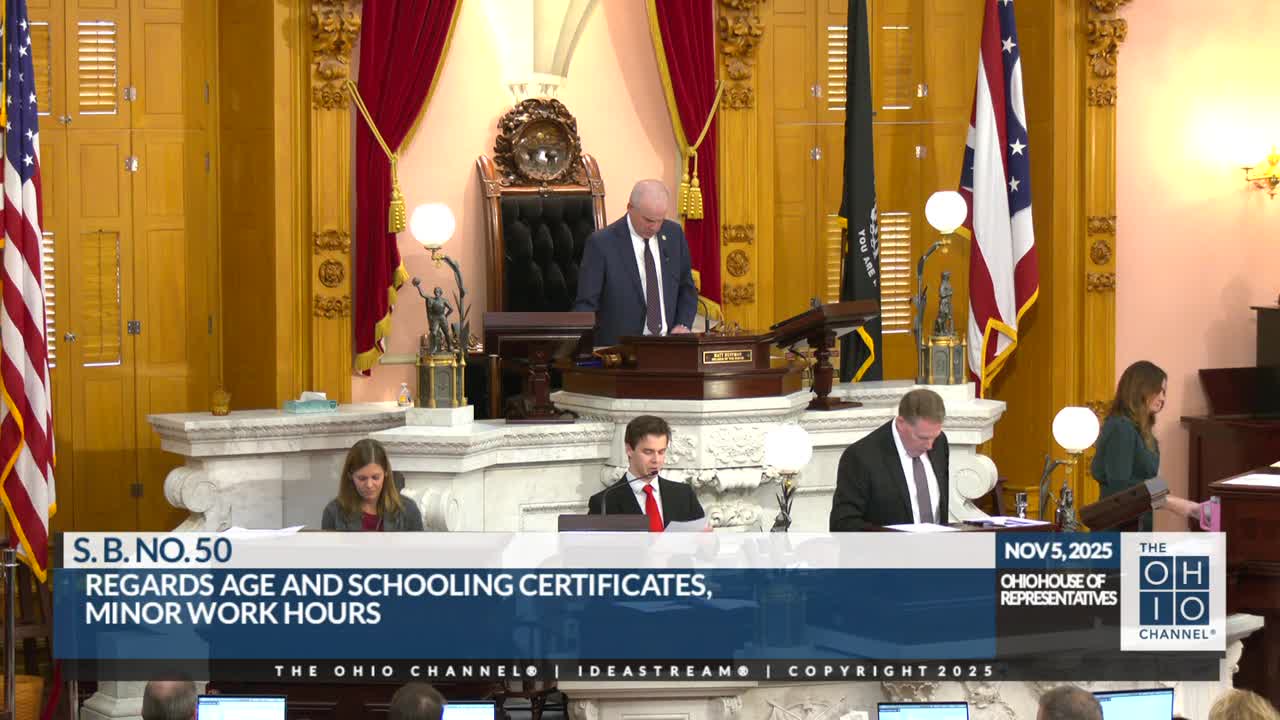Ohio House approves measure to let 14- and 15-year-olds work later on school nights amid fierce debate
November 05, 2025 | House of Representatives, Committees, Legislative, Ohio
This article was created by AI summarizing key points discussed. AI makes mistakes, so for full details and context, please refer to the video of the full meeting. Please report any errors so we can fix them. Report an error »

The Ohio House of Representatives voted to approve Senate Bill 50 on a floor vote after extended debate, with the motion passing 60 affirmative to 30 negative. The bill would allow persons under 16 to be employed between 7 p.m. and 9 p.m. during the school year if federal law is modified to permit such hours.
Proponents, including Representative Johnson, framed the measure as expanding opportunities for young workers and said current state rules mirror federal limits that could be changed by Congress. Johnson urged members to support the measure as a pragmatic step addressing workforce shortages. Representative Sweeney and other backers recounted local workforce needs and said procedural safeguards—such as existing work-permit requirements involving parental and school signoffs—remain in place.
Opponents delivered forceful objections on the House floor. Representative McNally said the policy would amount to “exploitation, plain and simple,” recounting federal investigations alleging children were already found working in hazardous conditions and arguing the state should not “hand corporations a new generation of underpaid, overworked, under protected employees.” Representative Erica White warned that the proposal shifted adult policy problems onto children and urged investment in adult wages, childcare and other alternatives rather than extending youth work hours.
The House recorded a roll-call tally of 60–30 in favor, meeting the constitutional majority required for passage. The bill’s enactment remains contingent on any changes to the federal Fair Labor Standards Act; sponsors and several members noted that federal law currently restricts work hours for 14- and 15-year-olds.
What happened next: the House deemed the bill passed and proceeded to agree to the title; the clerk announced the tally and formal passage. There was no recorded amendment to change the bill’s operative federal-dependency language on the floor during this session.
Why it matters: supporters said the bill could provide opportunities and align Ohio with a perceived need for flexible labor; opponents said it threatens student safety, education and longstanding child-labor protections. The change could take effect only if the relevant federal statutes are amended.
Proponents, including Representative Johnson, framed the measure as expanding opportunities for young workers and said current state rules mirror federal limits that could be changed by Congress. Johnson urged members to support the measure as a pragmatic step addressing workforce shortages. Representative Sweeney and other backers recounted local workforce needs and said procedural safeguards—such as existing work-permit requirements involving parental and school signoffs—remain in place.
Opponents delivered forceful objections on the House floor. Representative McNally said the policy would amount to “exploitation, plain and simple,” recounting federal investigations alleging children were already found working in hazardous conditions and arguing the state should not “hand corporations a new generation of underpaid, overworked, under protected employees.” Representative Erica White warned that the proposal shifted adult policy problems onto children and urged investment in adult wages, childcare and other alternatives rather than extending youth work hours.
The House recorded a roll-call tally of 60–30 in favor, meeting the constitutional majority required for passage. The bill’s enactment remains contingent on any changes to the federal Fair Labor Standards Act; sponsors and several members noted that federal law currently restricts work hours for 14- and 15-year-olds.
What happened next: the House deemed the bill passed and proceeded to agree to the title; the clerk announced the tally and formal passage. There was no recorded amendment to change the bill’s operative federal-dependency language on the floor during this session.
Why it matters: supporters said the bill could provide opportunities and align Ohio with a perceived need for flexible labor; opponents said it threatens student safety, education and longstanding child-labor protections. The change could take effect only if the relevant federal statutes are amended.
View full meeting
This article is based on a recent meeting—watch the full video and explore the complete transcript for deeper insights into the discussion.
View full meeting
